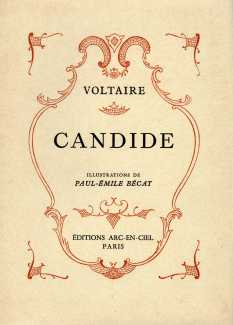 It was virtually inevitable that at some point Bécat would be commissioned to illustrate the best-known and widely-read French writer of the eighteenth century, and this five-volume collection of Voltaire’s works includes all of his most famous stories and novels – Candide (1759), Zadig (1747), Micromégas (1738), Le taureau blanc (1774), La princesse de Babylone (1768), Lettres d’Amabed (1769), L’ingenu (1767), Le blanc et le noir (1764), and L’homme aux quarante écus (1768).
It was virtually inevitable that at some point Bécat would be commissioned to illustrate the best-known and widely-read French writer of the eighteenth century, and this five-volume collection of Voltaire’s works includes all of his most famous stories and novels – Candide (1759), Zadig (1747), Micromégas (1738), Le taureau blanc (1774), La princesse de Babylone (1768), Lettres d’Amabed (1769), L’ingenu (1767), Le blanc et le noir (1764), and L’homme aux quarante écus (1768).
Voltaire (1694–1788), whose given name was François-Marie Arouet, was an enlightenment-era writer, philosopher, satirist and historian. Famous for his wit and his criticism of Christianity and of slavery, he was a vociferous advocate of freedom of speech, freedom of religion, and the separation of church and state. He used his novels and stories to challenge established norms of society, religion and human relationships.
His most famous work, Candide, is a satirical novella that dismantles the idea of philosophical optimism, exposing the cruelty and hypocrisy of a world plagued by religious persecution and social injustice. Through Candide’s journey, Voltaire critiques blind faith in authority, and mocks the institutions that sustain inequality. In Zadig and Micromégas, Voltaire adopts philosophical storytelling to question the arrogance of human reason and the moral failings of organised religion. He frequently presents characters whose lives are upended by arbitrary fate or systemic injustice, illustrating his belief that society is deeply flawed and in need of reform. Voltaire's depiction of relationships tends to be sceptical and ironic, true love often being entangled with betrayal and illusion.
Voltaire’s prose is witty and incisive, designed not just to entertain but to provoke thought. His radical views, conveyed through satire and allegory, helped to lay the intellectual groundwork for modern secular and liberal thought. By exposing the contradictions of his time, Voltaire championed reason, tolerance, and the relentless questioning of authority.
Compared with many of the texts illustrated by Bécat, there were relatively limited opportunities to include naked flesh, but artist and publisher did their best to include as much as possible.
 The five-volume Bécat-illustrated Voltaire was published by Paris-based Éditions Arc-en-Ciel, in a limited, numbered and boxed edition of 2,200 copies, the first 200 of which also included a complete set of engravings in black to complement the coloured versions.
The five-volume Bécat-illustrated Voltaire was published by Paris-based Éditions Arc-en-Ciel, in a limited, numbered and boxed edition of 2,200 copies, the first 200 of which also included a complete set of engravings in black to complement the coloured versions.





























































